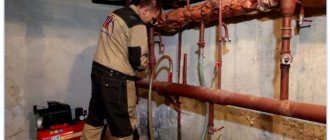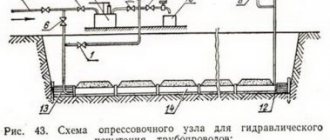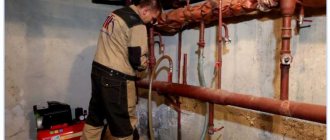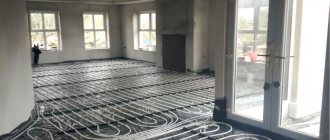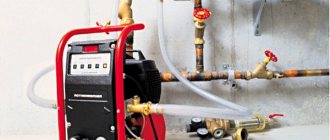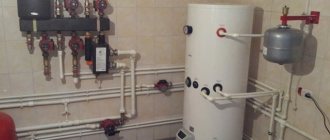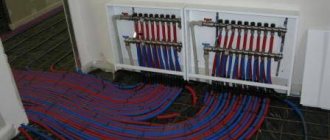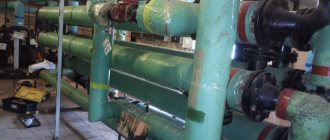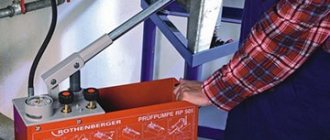When installing new space heating circuits, you need to check them for leaks. For this purpose, pressure testing of the heating system is used, since it can be used to test the system. Let's consider what types of this check there are, how they differ, and also what systems they are suitable for. We will also get acquainted with the process of crimping and washing circuits in multi-storey buildings and on private plots.
Pressure testing of the heating circuit Source theservice1.ru
What is crimping and why is it needed?
After installing the entire heating system, it must be checked for functionality and resistance to high pressure. To do this, high pressure is created inside it using water or air. Most often, when checking, this indicator is exceeded by 2 times the normal operating pressure. This whole process shows what pressure testing of a heating system is.
To carry out this test, special equipment is used that can operate in manual or automatic mode. During the inspection, the performance of pipes, boilers, underfloor heating systems or radiator circuits, as well as their connections and pumps for moving water, is analyzed. If the test was successful and all joints remained sealed, then the system can be handed over for operation and can be used in normal mode for a long time.
Testing heated floors Source stopradiators.ru
When is pressure testing carried out?
Hydraulic tests of the heating system are carried out both for new pipes that have just been installed, and for old ones, to check their resistance to pressure changes. The rules for the use of power installations from the Ministry of Energy of the Russian Federation (clause 9.2.12) indicate the standards for conducting inspections and how often they need to be carried out. Flushing and pressure testing of the heating system is done in 3 cases:
- Before the system is handed over for operation or before the heated floor is poured or pipes are installed, the first run is carried out. It is needed to check the system for leaks before it is covered with concrete or other materials, so that after startup they are not damaged by water. It is recommended to carry out an additional (second) check immediately after sealing the system. This will allow you to understand whether damage or pressure points appeared on the pipes during installation.
An example of an open system Source vsks24.ru
- After the end of each heating season, the pipeline should be pressure tested so that there are no problems if it is put into operation unexpectedly. Also, an additional check should be done before the start of cold weather.
- If the system has been repaired or has been idle for a long time, it is necessary to conduct an additional test for stability and leakage. Before doing this, you should drain the old water or liquid that is poured inside the pipes.
All tests are necessary in order to avoid repairs or unnecessary expenses during active use of the system. Most often these are the winter months, when the heating season begins.
Example of a leak Source www.4brothersbuyhouses.com
Why is hydro testing necessary?
Hydrotesting – checking the integrity and tightness of the heating main. Testing allows you to timely detect leaks and gaps at the points of threaded connections of fittings and battery connections, which can lead to leakage and flooding. Hydraulic tests are a mandatory measure at the stage of preparing pipelines for commissioning.
Important! If there is no certificate of testing the system in the building, the heat supply organization has the right to refuse to supply heat to the system.
The companies operating the structure are informed about the period of testing. The process is carried out by specialized companies whose employees have the necessary qualifications. Preparation of heat supply systems includes pressure testing of the main line and flushing of pipelines.
System Test Codes and Regulations
After familiarizing yourself with what “pressure testing of the heating system” is, you should understand the rules and conditions for its implementation:
- The air temperature around the pipes should not be below 0 °C outdoors and +5 °C indoors. If it does not meet the standards, then the test can be carried out only in emergency cases.
- After checking, there should be no condensation on the welds, as well as leaks in all joints or heating equipment.
- The pressure inside the heating circuit should not drop below 0.2 bar within 5 minutes, and for panel systems - 0.1 bar (atmospheres) within 15 minutes.
- During the test, the pressure inside a system that has metal pipes should not drop by more than 0.5 bar within 10 minutes, and for plastic pipes it should not drop by more than 0.6 bar in the initial 30 minutes and 0 .2 bar for 2 hours.
- If the system is tested not with water, but with air, then the pressure drop should not exceed 0.2 bar in the first 5 minutes.
Checking circuits with air Source blogspot.com
The pressure in pipes and heating devices when pressure testing the system should not be higher than the maximum permissible value for the components and materials of which it consists. Also, the pressure must be higher than 0.6 MPa and exceed the working pressure by no less than 50%. All places that will be hidden after wiring must be checked before finishing activities. If the pressure inside the system begins to drop, then you need to find the leak and seal it. After this, the test should be resumed.
For pipelines with valves, you need to make 2 full turns of the handle before starting the test. Heating devices that consist of sections and are not factory assembled must be crimped on site in the same way as large component parts. All system checks should be carried out before wrapping the pipes with thermal insulation, as this may make it difficult to find a leak.
Pipes with insulation Source ostroymaterialah.ru
If the pipeline and its components have passed all tests, then this must be recorded in the heating system pressure test report. It is also recommended to test it for proper heat distribution and uniform heating of the components. To do this, keep the water temperature inside the system at least +60 °C for 7 hours. If it is not possible to carry out these checks in the summer, then they are postponed until the heating devices are connected or the heating season.
Checking the pressure in the system Source edinayauk.rf
Drainage
Heating points are equipped with a ladder for gravity drainage of water, and if this is not possible, with a drainage pit with a pump (SP 124.13330.2012 Heating networks. Updated version of SNiP 41-02-2003 clause 14.20). The pit is closed with a removable grate. The latest innovation is that the edge of the pit should be painted with yellow and black stripes.
If the TP has a safety valve, then it must be equipped with a drainage pipeline so that in the event of operation no one (or nothing) is harmed.
Test Tools
To test the system for resistance to high pressure, a special device is used, which is called a pressure tester. It is a pump capable of creating pressure inside the system up to 60 or 100 atmospheres, depending on the type of mechanism. There are 2 types of pumps: manual and automatic. They differ only in that the second option stops pumping itself if the pressure reaches the desired level.
The pump consists of a tank into which water is poured and a plunger pump with a handle that moves it. On the body of the mechanism there are taps to block the pressure supply and pressure gauges to regulate the pressure. There is also a tap on the tank that allows you to drain the water that remains in the tank.
The principle of operation of such a pump is similar to a conventional piston analogue, which is used to inflate tires. The main difference is the cylindrical piston made of steel. It is fitted tightly inside the housing and a minimum gap is created, which makes it possible to pump up pressure up to 60 atmospheres.
Manual blower Source amazon.com
For hand pumps, the biggest disadvantage is that such pressure testing of pipes will take a very long time due to pumping the system with water. This process can take several hours, since large systems that have radiators will need to be filled manually.
Automatic devices work on a similar principle, but when the pressure limit is reached, they turn off themselves. They also require electricity to operate, so manual ones are more suitable for places where there is no power supply yet. Automatic pumps can pump pressure up to 100 bar, and industrial devices up to 1000 bar.
Electric version of the compressor Source ngenix.net
See also: Catalog of house projects with a boiler room up to 1 million rubles
Pipe crimping
There are 2 different methods of heating heating: water and air. Using the first option, all thermal systems are most often tested. To do this, liquid under pressure is pumped into a special tap, with which you can quickly detect breakouts and leaks.
The air method is a less effective method for checking pipes, but its main advantage is that during frosts water cannot be used, as it may freeze. To find leaks, soapy water is used to lubricate suspicious areas. The main search method is to determine a breakthrough by ear. The pressure in the system is built up using a compressor through a valve into which water must be supplied.
For multi-story buildings, there are certain testing rules that indicate the minimum pressure for the test. In water heating, panel and convector systems it should be 10 atmospheres, and in a circuit with steel or cast iron pipes - 6 bar.
Insulation and warning colored rings on pipelines
All pipelines in the ITP (CTP) must be painted and insulated. The insulation should not hang in rags, everything should be neat. Metering units and elevators are also isolated.
Markers on the pipeline should indicate the direction of movement of the coolant. To identify the contents of the pipes, warning colored rings are applied to them. For heating, rings of green (primary color) and yellow are used on the supply, green and brown on the return. The same marking is used for DHW. Drainage and cold water supply are indicated by green rings.
Video description
This video shows why pressure testing of the system is necessary.
To carry out the work, water with a temperature of 42 °C is poured into the heating circuit and air is released through special valves. Within 10 minutes, a test pressure is created, with which the joints are checked for leaks. After this, the pressure is increased to the required standard and a test is carried out for 10 to 30 minutes, depending on the material from which the system is made.
On private plots, the test can be carried out no more often than once every 4-5 years. To do this, you do not need to have a lot of knowledge and skills, and the entire procedure can be done independently, if you have the necessary equipment. In order not to spend a lot of money on purchase, you should rent a compressor or call a special service to check the pipes.
Checking pressure by a specialist Source inkrasnogorsk.ru
In a high-rise building
Pressure testing of heating pipes in multi-storey buildings is most often done in the middle or end of spring, after the heating is turned off. If complaints are received about low water temperature, then the heating company must carry out a calculation of the radiators. Under certain conditions, they can be replaced, removed or new ones added. During the inspection, all risers are checked for blockages and washed under high pressure along with the rest of the system.
Also, during inspections, insulating gaskets, seals on cast iron valves and stuck bolts should be changed. During this, the fittings in elevators and pipes are inspected. This is to check them for rust or damage. After all the tests, the condition of the heat-insulating materials on the line is analyzed.
At the end of the checks, it is necessary to carry out pressure testing of the pipes, taking into account the material from which the system is made and the operating pressure of the system. If the pipes are made of cast iron, then the pressure does not rise above 6 atmospheres, and if they are in the walls - no more than 10 bar, as with panel heating systems.
Example of cast iron radiators Source radiator-home.ru
See also: Catalog of companies that specialize in heating, water supply, sewerage and lighting
Pipe inspection is done in 2 steps. To do this, first the entire heating system is checked, and then its individual sections are tested under higher pressure. To do this, the heating circuit is filled with water, which has a low pH level, which avoids the formation of deposits on the pipes. The pressure is increased using electric pumps, since it is often impossible to manually fill such a volume.
If the pressure has not dropped within 30 minutes, then pressure testing can be completed. If there is a leak, it must be found and removed, and then the test must be repeated. Each node is individually checked in a similar way, only the pressure is increased to 10 atmospheres.
Thermometers
The thermometer sleeve (pocket) should extend 2/3 into the pipeline, so that the immersed part is in the center of the flow.
This shows an incorrect pressure gauge connection.
To ensure good thermal contact, the thermometer sleeve must be filled with mineral oil (GOST 8.586.5-2005 clause 6.3.9.).
Video description
This video shows a test of a separate system unit using air
On a private plot
For private areas, most often the working pressure does not exceed 2 atmospheres. Therefore, when checking, a pressure of 4 bar is used. Car pumps or small compressors can be used during testing.
Before checking the pipes for leaks and pressure resistance, it is necessary to drain all liquid from the system into a large container for reuse. This is necessary to ensure that coolant with impurities does not enter the system. After this, a special liquid with special additives is poured into the circuit, which helps flush the pipes from excess dirt, scale or rust.
Before flushing the system, it is necessary to clean all water filters and put them back. Cleaning the pipes can be done several times, if necessary, and the water temperature should be from 55 to 60°C. After each run of the purifier, the water filters should be checked. The rinsing can be completed if they remain clean after the test.
Pressure testing with water Source konyademirdokum.com
If the water remains clean after washing, it can be reused to build up pressure during pressure testing. But for this you should let it cool to 40-45 °C. If a manual blower is used, then water must be poured into its tank and the pressure in the system increased using a lever. After it has reached the desired mark, the circuit must be checked within 30 minutes.
Similarly, with multi-storey buildings for private plots, it is also necessary to re-test the system if the pressure drops below normal. To do this, you must first find and repair the leak.
If the pipes are under a concrete covering, and there are no leaks in open areas, then you need to look for wet spots on the surface of the walls or floor, since if depressurization occurs there, the water will wet them. You can also use a thermal imager to detect leaks. If the spots are not visible and the pressure drops, then at high temperatures you can find the problem area using this device.
Elevator
The principle of operation of the elevator unit.
The main requirement for the elevator unit is flushing the cone (nozzle). The diameter of the hole in the cone is 5-7 mm (calculated individually for each building); if the cone is clogged, the required amount of heat will not flow to the building.
The elevator must be sealed. To wash the nozzle, the seal must be removed, but to avoid unnecessary questions, this must first be agreed upon with the inspector who will accept the pressure test from you. After washing, the elevator is sealed again.
Often inspectors require that a tag hang on the elevator with the diameter of the hole in the cone indicated on it.
Video description
This video shows why the pressure in the circuits may drop
Open systems with air
Air testing can be used to test open heating systems. Most often, an expansion tank is used to create pressure in private areas, and the pressure in the system when using it is 1 bar. Therefore, for testing, this parameter will be 2 atmospheres, which can be pumped up using a conventional hand pump.
Before performing the test, all liquid from the system must be drained (preferably into a separate container for reuse) and the pipes must be flushed. After cleaning, all water must be drained and tightly closed all places through which air can be released, for example, Mayevsky taps. It is also necessary to close the inlet pipe that leads to the tank. After this, you should connect the pump to the system through a special fitting using a hose, which is recommended to be secured with clamps, and begin to apply pressure.
Open heating circuit Source izion.pro
Pipe flushing
After familiarizing yourself with the fact that this is pressure testing of the heating system, you should consider one of the important components of this process, namely flushing the pipes. When pouring water into the system, the liquid may contain impurities that, during heating, can leave scale or salts on the walls of heating systems. This reduces the working cross-section of the pipes and can cause blockages, just like rust.
These 2 harmful impurities reduce the rate of heating and cooling of pipes and increase the pressure inside the heating circuits. This can lead to overheating of individual sections of the heat pipe and the formation of fistulas (cracks or holes). If scale or rust has formed a 1 mm layer on the wall, this will degrade the performance of the system by 15-20%, which will lead to a severe loss of thermal efficiency.
Example of a dirty pipe Source restreamsolutions.com
The main indicator of clogged pipes is the speed at which they heat up, the uniformity of this process, as well as increased fluid flow inside the circuits. To clean the system from harmful deposits, the system is pumped with water with special impurities, after which an air compressor is connected. It is needed so that, due to high pressure, turbulence is created in the water flow, which creates additional vibrations in places of deposits.
During such washing, scale and rust are torn off the walls and driven towards the filters. When carrying out this activity, you should close all air valves that should relieve excess pressure. It is also recommended to install a check valve at the junction of the compressor mount in order to avoid water backflow.
Flushing device Source www.lhps.co.uk
Documents for crimping
To carry out pressure testing of the system, you must have a plan, which is reviewed and signed by the chief engineer of the company that supplies heat. This document determines the sequence in which the inspection will be carried out, as well as what employees should do during the process. Also, after all checks, a pressure testing report must be drawn up, which describes:
- what verification method was used;
- the project for which the heating system was installed;
- the date of the tests, the address of the place of conduct and the names of those people who sign this act;
- what methods were used to fix leaks or problems in the circuit;
- test result;
- the presence of places that violate the tightness of the system and the formation of condensation on fittings or pipes.
After all checks, the act should be checked for errors or inaccuracies, and then signed. There is also a schedule for flushing and pressure testing the heating system, a sample of which can be seen below.
Pressure testing schedule Source yolatec1.ru
